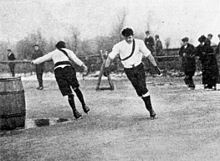Fens
The Fens (English: The Fens = the swamps) are a moorland and marshland in eastern England , which extends around the bay The Wash and was the floodplain of the rivers Witham , Welland , Nene and Ouse .
After the drainage under the direction of the Dutch engineer Cornelius Vermuyden in the 17th century, the course of the river Ouse changed and the land subsided, causing floods. The attempt to pump out the water with wind pumps had little success. It was only after the steam-driven pump was invented around 1820 that the floods could be contained. The conversion to pasture and arable land was not completed until the middle of the 19th century. Due to the sagging of the drained bog soil, parts of the Fens are now up to 4.6 meters below sea level .
Around the turn of the 18th and 19th centuries, the flooded areas often froze over in winter, and so the bandy, similar to ice hockey , developed here . Bandy games of the Bury Fen Bandy Club are mentioned as early as 1790. There were also early speed skating competitions of the then popular fen skaters , where prizes could be won (see also the history of speed skating ).
The Wicken Fen nature reserve gives an impression of the Fens before they were drained . The Fens vegetation has been replanted in the Botanical Garden of the University of Cambridge , including the marsh ragwort, which is almost extinct in Great Britain, as well as the caraway-leaved silge and the non-burning nettle Urtica dioica subsp. subinermis .
See also
Individual evidence
- ↑ Juliet Day, Tim Upson (Ed.) 2012, The Guide. Cambridge University Botanic Garden. Expanded reprint of: John Parker, Guide to the Cambridge University Botanic Garden, 2002. Cambridge, Cambridge University Botanic Garden, 62.
Web links
Coordinates: 52 ° 29 ′ 0 ″ N , 0 ° 14 ′ 0 ″ W.

